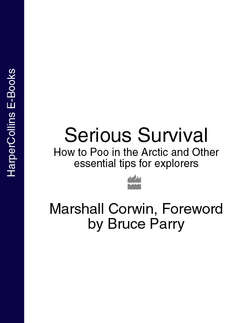Читать книгу Serious Survival: How to Poo in the Arctic and Other essential tips for explorers - Bruce Parry - Страница 15
ОглавлениеHypothermia
There comes a point when being ‘a bit cold’ turns into something much more serious. As warm-blooded animals we need to stay at a pretty constant temperature of around 37°C (98°F) for our vital organs to work properly.
The body does an amazing job over a massive range of activities and outside temperatures, but in extreme conditions it may eventually not be able to cope.
It only takes a fall in body temperature of a mere two degrees to around 35°C (95°F) for hypothermia to set in. A victim will feel sluggish and groggy, unable to think or speak clearly, and will suffer from violent shivering as the body tries to generate energy.
If not treated quickly, hypothermia can be fatal. A sure sign it’s turning critical is when shivering stops completely. This happens as the body temperature falls further and energy reserves are used up. Everything in the body slows down including the pulse and breathing, so much so that there are cases where people have been assumed to be dead, only to recover completely on rewarming.
TREATMENT FOR HYPOTHERMIA
Firstly, get the victim out of the cold if possible, for example, by putting up a tent to get out of the wind. If they got cold quickly then they probably have only mild hypothermia and can be warmed up pretty fast.
If, however, the casualty’s core temperature has fallen below 32°C (90°F) they must be handled extremely gently and discouraged from doing too much to help (there is serious risk of arrhythmia, where the heart stops beating normally). Rewarming should be done very gradually by wrapping them in blankets and giving them warm drinks if possible. The body heat of another person is also effective (ideally by getting into a sleeping bag naked with the victim).
Seek expert medical help as soon as possible and get the casualty to hospital. There, warm fluids may be put into the veins and other areas, such as the chest cavity and abdomen.
WIND CHILL
The ‘wind chill factor’ is often mentioned on weather forecasts nowadays, as it’s become recognised that the wind can have a serious effect on how quickly you get cold. Just as you blow on hot food to cool it down, the wind takes away warm air from the surface of your body, cooling you down much more quickly. A chart has been devised by scientists to show what the temperature feels like at various wind speeds. For example, at –9°C (16°F) with a 24km/h (15mph) wind, it feels similar to –18°C (–0.4°F) on a still day.
WIND CHILL CHART
The numbers in the coloured areas of the chart represent how cold it feels at various temperatures and wind speeds.
Danger of frostbite
Low risk
Exposed skin starts to freeze in around 5-10 mins
Exposed skin starts to freeze in around 1-2 mins
Exposed skin starts to freeze in around 30 secs
A strong wind can make temperatures seem much colder than they really are.
The author filming Serious Arctic in temperatures of around –30°C (–22°F).
DOES MINUS FIFTY really feel any colder than minus ten or twenty?
A good question – once you’re absolutely freezing how can you possibly feel any colder? It’s really about the ability to keep warm and how quickly you are in trouble. You can almost feel the heat being sucked out of your body at extreme low temperatures. All the clothes in the world don’t seem to keep you warm without a lot of leaping about, and frostbite and hypothermia can quickly set in.
WHY IS IT dangerous to sweat?
Surprisingly, one of the key problems in the freezing Arctic is getting hot and sweaty (all too easy when you’re wrapped from head to toe in layer upon layer of clothing). Odd though it first seems, getting too hot means you quickly get too cold.
The reason is that if you let yourself sweat, the perspiration freezes within seconds. You then have a layer of ice next to your skin, which means you are on a slippery slope to frostbite and hypothermia. In short: you sweat – you die!
That’s why layering is so important (see page), removing or putting on layers of clothes as necessary. All experienced Arctic adventurers start the day with the minimum number of layers on. Although they may feel cold for a few minutes, they know the strenuous activity ahead will soon warm them.
SMALL MISTAKE, BIG PROBLEM
Take extra care not to spill water or other liquid on your gloves or other vital bits of clothing. The resulting frozen item of clothing will be all but useless, and will take a lot of time and effort to sort out, either heating and drying it above a stove or taking it with you inside your sleeping bag overnight.
If you ignore the problem, you may again be on the route to serious cold injuries. Letting snow get inside your gloves will have similar effects. The heat of your hands will melt it, the water will turn into ice and off you’ll go again down that slippery slope.
Pulling pulks across the sea ice is a constant juggle between overheating and possible hypothermia and frostbite.
